Our chase boat was pushing its limits, bouncing up and down on the water at 20+ knots as we tried to keep up with the Patriot on a beautiful, sunny day in Barcelona. It was a futile attempt; the futuristic sailboat zoomed out of sight in almost an instant.
This was my second day visiting the American Magic team at the bustling Spanish harbour, laden with superyachts and other gigantic vessels, as they were getting ready for the 37th America’s Cup, one of the strangest competitions in the world.
If you don’t know what Amerca’s Cup is, let me tell you, you’re missing out. It’s the oldest international sporting trophy, dating back to 1851. The prestigious sailing competition pits the world's best sailors and most advanced yachts against each other.
Only four nations (United States, Australia, New Zealand, and Switzerland) have won the America’s Cup in over 170 years. Emirates Team New Zealand, after defeating Oracle Team USA in 2017 and defending the title in 2021 against Italy, is the most successful team in modern history with four wins.
The 37th edition will be held in Barcelona from August to October 2024, hence why all teams are testing the waters there, literally and figuratively. The current defender is Emirates Team New Zealand, which will face the winner of the Challenger Selection Series, the Louis Vuitton Cup.
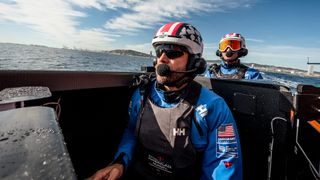
One of the challenger teams is the New York Yacht Club’s American Magic, a prominent team with a long and rich history.
Formed in 2018 by Hap Fauth, Roger Penske, and Doug DeVos, New York Yacht Club American Magic aims to reclaim the America's Cup, which the club has held for 132 years since 1851. The team faced a dramatic setback in the 36th America's Cup when their AC75 'Patriot' capsized during a leading semi-final race against Luna Rossa Prada Pirelli.
For the 37th America's Cup, American Magic signed Tom Slingsby, an Olympic gold medalist and renowned foiling sailor, partnering with Paul Goodison. They introduced AC75 cyclors and refined their systems with SRAM. They also formed 'Quantum Racing powered by American Magic' to develop young and female sailors.
Led by CEO Mike Cazer and Design Coordinator Scott Ferguson, the team launched their new AC75 'Patriot' in May 2024 (see video below) and immediately started testing. This effort represents their best chance in decades to bring the Cup back to New York.
The Patriot is not dissimilar to other boats taking in the competition, which isn’t much of a surprise, as the winning team dictates basically every parameter of the race, including what kind of boats are used, which all challenger teams have to adhere to.
The AC75 racing yachts are very different from the white sailboats you might be accustomed to. They have a monohull construction (unlike the double-hulled catamaran, for example), feature wing-like sailing hydrofoils mounted under the hull, a soft wing sail, and no keel.
“I'm still amazed by how exciting it is to see the AC75s barreling down the racecourse at four times the speed of the wind,” says Aaron Perry, Global Platform Design Lead at American Magic. “If you're on board and raise your head out of the cockpit, you'd be feeling near hurricane-strength wind speeds. A Category One hurricane is 64 knots, and that's just about what you'd be feeling on the boat.”
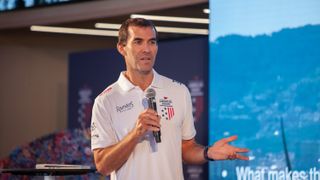
Aaron Perry, Global Platform Design Lead at American Magic
A sailing hydrofoil is a marvel of nautical engineering that transforms sailboats into high-speed machines by lifting the hull above water and dramatically reducing drag.
Here's the magic (pun intended): as the boat accelerates, water flows over and under hydrofoil wings mounted below the hull. These foils create a pressure difference, generating lift similar to how aeroplane wings work.
What makes for a winning design starts with the takeoff of the boat. The hull is in the water, and the sails provide thrust at low speed. As the boat speeds up, the foils, which are stainless steel slivers in the water, begin to provide lift, and the hull slowly lifts out of the water.
The underbody is shaped like a canoe to reduce wet surface and hydrodynamic drag as you accelerate. Eventually, the hull is completely out of the water, and the hydrofoils alone balance its nearly seven-ton weight.
The most insane thing about the Partiot – and other AC75 racing yachts – is that no engine or motor pushes the vessel forward; its forward motion is powered by wind only. There are eight people on board the boat: four responsible for manoeuvring it and four cyclors (cyclists-sailors) generating power for the hydraulics.
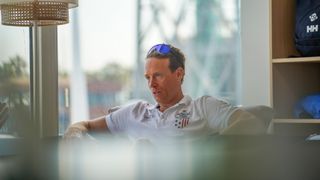
Paul Goodison
“You do get thrown around a lot, experiencing a couple of Gs through turns,” explains Paul Goodison MBE, one of the helmsmen of the Patriot. “It's almost like driving a go-kart, where you're wobbling around in your seat, and your head gets rocked around.”
The physicality is really different between the different roles. A certain amount of power has to be produced to move all the sails on this boat, and that's primarily down to the four guys who form the power unit, the cyclists on board.
“You can only move [the sails and wings] as fast as the guys can produce the power,” adds Paul. “The cyclists are producing phenomenal amounts of power, averaging between 450-500 watts for 20 minutes, which is mind-blowing.”
As a huge fan of physical fitness and endurance, I was fascinated by the cyclors. It’s almost unfathomable what those guys go through while on the boat.
The current design (it changes from cup to cup) requires American Magic cyclors to face backwards in a recumbent position, not really seeing anything apart from the scenes mounted in front of them.
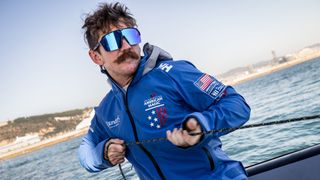
The Helly Hansen Foil X Jacket in action
Although the type of boat the teams are using is the same, only American Magic uses a recumbent bike setup to power the hydraulics. All while wearing full sailing suits designed specifically for them by Helly Hansen.
Helly Hansen worked closely with American Magic to design the outfit for everyone on board, including the cyclors. The Foil X Jacket (retailer link) is a good example of this collaboration; better still, you can buy the jacket and pretend you're a member of the team like I did when I was there.
The brand says the waterproof jacket was inspired by the “X” patterns that carbon reinforcement yarns create on American Magic’s boat sails and features the HELLY TECH Professional 3-layer fabrics that offer the highest levels of waterproof and breathability, as well as next-level flexibility through 4-way stretch performance.
Not all Helly Hansen products designed for the team make their way to the public, but the technology used in the garments will be implemented in the brand's products. After all, Helly Hansen is trusted by thousands of professionals, including RNLI and other emergency service members, and I'm sure they could use high-performance, hard-wearing gear.

Ashton Lambie
“We power the sails. Anytime the guys are trimming the sails, we need to produce more power. It's not a constant all-out effort,” says Ashton Lambie, one of the cyclors. “There are points where we need to produce more power and points where we maintain a steady pace.”
The race is only 20 minutes or so, so cyclors need to be able to generate a lot of power quite quickly. They aren’t your skinny Tour de France riders; cyclors often come from a track cyclist background. Think Chris Hoy and co with their enormous legs.
Cyclors need to pass a test in which they generate 450W for 20 minutes straight to be considered for the American Magic team. After seeing the boat fly in the water on the second day, journalists attending the event, such as myself, jumped on the bikes to see how long they could last; I managed around 60 seconds at 450W before my legs turned to jelly.
To maintain their physiques, American Magic team members have to train a lot. Cyclors like Ashton are in the gym three days a week, sailing three to five days a week and fitting in one or two long rides if they can.
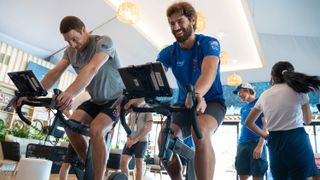
Cyclors Ethan Seder and Austin Regier causally riding two Wahoo KICKR BIKES
“Some guys enjoy riding outside, but I focus on our recumbent setups to mimic the boat conditions,” Ashton explains. “Platforms like Zwift make it fun. There was a group of three of us on the recumbents yesterday, and we did the Mega Pretzel route on Zwift. It's a big loop, and it’s a good way to pass the time while training.”
Thanks to all the workouts, the cyclors are getting bigger and more muscular by the day – Ashton added 15 kg to his overall mass and increased his bench press by 40 pounds – but since there is a weight limit for each person on the vessel, this means the other four members of the stuff have to lose weight, so the cyclors can get bigger.
The weight limit for the eight guys on board averages around 87.5 kg,” explains Paul. “For every kilo I'm below that, one of the cyclists can be above it. It's a trade-off because I don't need to produce power, so I try to get as small as I can so the cyclists can be bigger and stronger.”
All that indoor training comes at a price, though. I was told that some of the cyclors are vitamin D deficient because they spend so much time indoors. Considering that most of them have been living in Barcelona for a year and a half, it’s crazy that they don’t get enough sunshine.

The whole American Magic team is kitted out with top-notch Helly Hansen gear
“It's similar for all of us. We're either in the office or on the water sailing, usually covered with helmets and goggles, so there's limited sun exposure,” Paul explains. “Especially through the winter months, many of us are iron and vitamin D deficient, so we take supplements to stay stocked. Now that the weather is getting better, we need about 15 minutes of sun exposure daily.”
I couldn’t help but notice that both Asthon and Paul wore Garmin watches, so naturally, I had to ask them if they used their smartwatches for training. Ashton says he wears a Garmin every day to maximise sleep and training and monitor overall fatigue. Not surprisingly, Paul says he also uses his Garmin “all the time” for training and to see how much work he's doing.
How will the American Magic team fair at the 37th America’s Cup? Only time will tell. The team seems confident, and the racing yacht is amazing, so there is hope for the New York Yacht Club to reclaim the trophy.
I’m sure they wouldn’t mind lifting the cup above their heads after winning, as the American Magic effort costs upwards of 100 million dollars to execute. Even if that doesn’t happen, there is always the 38th Cup in a few years time…



